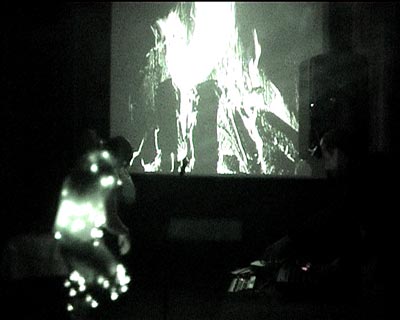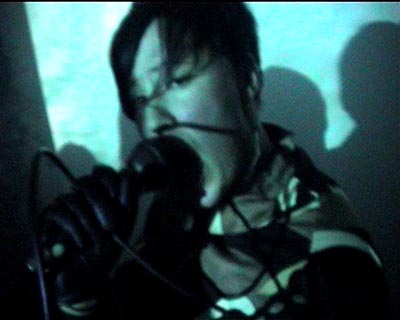MATTI KALLIOINEN
Photos
Interview between Matti Kallioinen
and Peter Cornell that is made exclusively for the record release
on Abnormal Audio.
Peter Cornell is an art critic
and professor of art theory at the Royal College of Art in Stockholm.
Stockholm, September 2002
Peter Cornell: All your works
have a magical immediacy, are impossible tostay out of. Often
you inhabit them yourself. In Gnome House soup was being made,
you were boiling broth from what was left after the gallery had
been cleaned. People gathered round the stewing pot, looked at
the slides projected on the walls (a crumb of dough in each glass
frame) or could play a game in the inmost room if you guessed
which of raisins spread out on the floor was correct, you could
eat it. In your This is Where Junior Lives we suddenly found ourselves
in the room of an 11-year-old; and your happy face stuck up from
a little white podium on the floor like a living sculpture. There
were Pampers diapers on the walls, a cute picture of a cat, a
container of raspberry squash in the corner for visitors and a
little dog on the floor. I remember my reaction of exhiliration
and suppressed, scarcely perceptible fear: you displayed yourself
like a freak with no body and no protection.
The spirit of this and your other works is related to a relational
aesthetic, but at the same time they are bizarre. What is your
view of the relationship?
Matti Kallioinen: The positive
thing about relational art was that (at its best) it came gushing
out straight into the face of the often amazed spectator, instead
of turning inwards. However, the movement soon became a prototype
for the production of art in the 90s and gave rise to a cascade
of boring quasi-democratic works. The spectator was expected to
"participate by writing something on a Post-It or draw something
on a whiteboard. The artist never had to take the risk of being
disturbing and moreover it was/is easy to get funding when you
pretend to be a democrat. But a democracy in which you never express
your own opinion and always bounce questions on to someone else
is, after all, totally sick. What I missed a lot more in art was
people who expressed their visions in a way that made them real,
tangible, or even importunate for the world around them.
I want to meet the viewer face to face, out of pure curiosity.
It was somewhere there that Junior was born, as a strategy for
creating this kind of encounter. Being seen as bizarre is a sign
for me that I am communicating something that is not already taken
for granted.
PC: Junior is there some kind
of strategy in the childishness? Your works often contain references
to children, in the materials, the play situations, caves and
shadowplay and a Grimms, Fairy Tale feeling of something both
wonderful and frightening. This is true for instance of the works
where you use food and drink and body fluids in a kind of experiment
that involves both slapstick and compulsion.
MK: Art for me is playing. I
would rather play when producing art than make "real art,
whatever that might be. The idea that playing is childish or cute
is not true. Playing is about locating power, defining limits,
determining what it is possible to say, do or think. Slapstick
and compulsion, isn,t that what the body is best at?
When you spend as much time in information worlds as we do today,
your body, digestive system and body fluids become a kind of alien,
nasty, hyper-reality outside the world in which your brains function.
You don,t feel at home in your body, and it even has the cheek
to threaten your life if you stop eating!
The brews and juices that are drunk in my art point to various
sides of this, a blind, suckling new-born kitten, an alcoholic,s
unconsoling thirst or a beaker of blood quaffed in some pompous
sacrificial rite in a B horror movie. The thirst itself in your
mouth for some miraculous substance. A bit like Dracula, although
even closer to Dr. Jekyll
PC: And you call your CD "Juice
Concentrate a title that indicates the link between your artistic
use of sound and image. Can you tell us a bit more about the ideas
behind your music and where it originates?
MK: There are no strict boundaries
between my art and my music. I see the music as a kind of abstract
puppet show with different characters acting short scenes, very
visually in other words. And I want listeners to experience the
music that surrounds them in space as fantastic scenography.
My music can sound as if it is a very eclectic form of entertainment.
I see it as something to be consumed, not an accessory or an argument
for some specific sub-culture.
Creating melodies is like needlework for the ears, it,s what I
do to relax, a form of doodling.
PC: As far as I can see music
has always been close to you ever since you played the violin
while you were growing up in Sundsvall in the north of Sweden.
You produce your CD,s by using totally different sounds and quite
a different technology. But despite the sophisticated electronics,
you allow your music to be have the kind of electronic sound that
I associate with the home electronics of the 70s and 80s. How
do you set about it?
MK: I use software that lets
you assemble your own instruments using small components that
either generate or modify the signals. It a kind of Lego for sounds,
very like the way in which the modular synths of the 60s worked.
Electronic recordings from those days (Perrey-Kingsley, Bruce
Haack, Dave Vorhaus, Joe Meek for instance) are full of inventiveness,
humour and playfulness, and this has inspired my sound. Sampling,
which came in the 80s, is really the only new thing that has happened
with sound since then. Otherwise the evolution of the synth has
focused on the more limited instruments, because they were easier
to use and to sell.
During the 80s electronic music took on its own stereotype in
the fashionable, young synth culture. But the music that has really
influenced me is music of computer games.
The primitive sound cards in home computers in those days forced
music to focus on good and ingenious melodies. They were often
more innovative and flipped out than popular music was. Ben Daglish
seemed to have no rules to obey except that it should never be
dull! Even so, it was not considered to be "real music in
the 80s.
When I like many other people began to rediscover this musical
treasurehouse at the end of the 90s it was an incredibly powerful
feeling. Music that at the end of the 80s had been considered
inadequate and vapid seemed to pulse with character and feeling
with the soundspectrum we have today.
But electronic music is only a part of what has influenced me.
The imaginative musical worlds of Tyrannosaurus Rex, Tiny Tim
and The Incredible Stringband are also some of the things that
have distorted my way of thinking, both as an artist, a musician
and a human being.
TOP
Concert with Matti Kallioinen
at Sparwasser HQ's Z-bar on October 31. 2002


TOP
|




